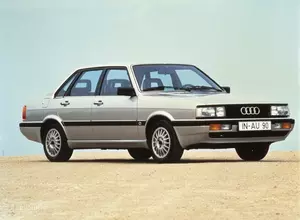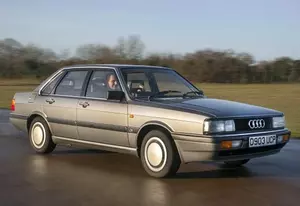
| Vehicle | Curb weight | Difference from world's smallest | Weight to power ratio | 0—60 mph acceleration ratio | Consumption ratio |
|---|---|---|---|---|---|
| 2.3 E 20V |
1320 kg / 2911 lbs |
895 kg (1974 lbs) heavier | 8 kg to 1 hp | 165 kg/s (364 lbs/s) |
132 kg/L (291 lbs/L) |
| 2.0 E CAT |
1110 kg / 2448 lbs |
685 kg (1511 lbs) heavier | 10 kg to 1 hp | 119 kg/s (262 lbs/s) |
134 kg/L (295 lbs/L) |
| 2.3 E CAT |
1220 kg / 2690 lbs |
795 kg (1753 lbs) heavier | 9 kg to 1 hp | 144 kg/s (318 lbs/s) |
134 kg/L (295 lbs/L) |
| 2.3 E |
1280 kg / 2822 lbs |
855 kg (1885 lbs) heavier | 10 kg to 1 hp | 147 kg/s (324 lbs/s) |
145 kg/L (320 lbs/L) |
| 2.0 E 20V |
1280 kg / 2822 lbs |
855 kg (1885 lbs) heavier | 8 kg to 1 hp | 154 kg/s (340 lbs/s) |
128 kg/L (282 lbs/L) |
| 2.0 E |
1110 kg / 2448 lbs |
685 kg (1511 lbs) heavier | 10 kg to 1 hp | 119 kg/s (262 lbs/s) |
128 kg/L (282 lbs/L) |
| 1.6 TD |
1090 kg / 2403 lbs |
665 kg (1466 lbs) heavier | 14 kg to 1 hp | 78 kg/s (172 lbs/s) |
206 kg/L (454 lbs/L) |
| 2.2 E |
1220 kg / 2690 lbs |
795 kg (1753 lbs) heavier | 9 kg to 1 hp | 144 kg/s (318 lbs/s) |
126 kg/L (278 lbs/L) |
| Vehicle | 2.3 E 20V |
|---|---|
| Curb weight |
1320 kg / 2911 lbs |
| Difference from world's smallest | 895 kg (895 lbs) heavier |
| Weight to power ratio | 8 kg to 1 hp |
| 0—60 mph acceleration ratio | 165 kg/s (364 lbs/s) |
| Consumption ratio |
132 kg/L (291 lbs/L) |
| Vehicle | 2.0 E CAT |
| Curb weight |
1110 kg / 2448 lbs |
| Difference from world's smallest | 685 kg (685 lbs) heavier |
| Weight to power ratio | 10 kg to 1 hp |
| 0—60 mph acceleration ratio | 119 kg/s (262 lbs/s) |
| Consumption ratio |
134 kg/L (295 lbs/L) |
| Vehicle | 2.3 E CAT |
| Curb weight |
1220 kg / 2690 lbs |
| Difference from world's smallest | 795 kg (795 lbs) heavier |
| Weight to power ratio | 9 kg to 1 hp |
| 0—60 mph acceleration ratio | 144 kg/s (318 lbs/s) |
| Consumption ratio |
134 kg/L (295 lbs/L) |
| Vehicle | 2.3 E |
| Curb weight |
1280 kg / 2822 lbs |
| Difference from world's smallest | 855 kg (855 lbs) heavier |
| Weight to power ratio | 10 kg to 1 hp |
| 0—60 mph acceleration ratio | 147 kg/s (324 lbs/s) |
| Consumption ratio |
145 kg/L (320 lbs/L) |
| Vehicle | 2.0 E 20V |
| Curb weight |
1280 kg / 2822 lbs |
| Difference from world's smallest | 855 kg (855 lbs) heavier |
| Weight to power ratio | 8 kg to 1 hp |
| 0—60 mph acceleration ratio | 154 kg/s (340 lbs/s) |
| Consumption ratio |
128 kg/L (282 lbs/L) |
| Vehicle | 2.0 E |
| Curb weight |
1110 kg / 2448 lbs |
| Difference from world's smallest | 685 kg (685 lbs) heavier |
| Weight to power ratio | 10 kg to 1 hp |
| 0—60 mph acceleration ratio | 119 kg/s (262 lbs/s) |
| Consumption ratio |
128 kg/L (282 lbs/L) |
| Vehicle | 1.6 TD |
| Curb weight |
1090 kg / 2403 lbs |
| Difference from world's smallest | 665 kg (665 lbs) heavier |
| Weight to power ratio | 14 kg to 1 hp |
| 0—60 mph acceleration ratio | 78 kg/s (172 lbs/s) |
| Consumption ratio |
206 kg/L (454 lbs/L) |
| Vehicle | 2.2 E |
| Curb weight |
1220 kg / 2690 lbs |
| Difference from world's smallest | 795 kg (795 lbs) heavier |
| Weight to power ratio | 9 kg to 1 hp |
| 0—60 mph acceleration ratio | 144 kg/s (318 lbs/s) |
| Consumption ratio |
126 kg/L (278 lbs/L) |

| Vehicle | Curb weight | Difference from world's smallest | Weight to power ratio | 0—60 mph acceleration ratio | Consumption ratio |
|---|---|---|---|---|---|
| 2.0 |
1060 kg / 2337 lbs |
635 kg (1400 lbs) heavier | 9 kg to 1 hp | 118 kg/s (260 lbs/s) |
123 kg/L (271 lbs/L) |
| 2.2 E |
1200 kg / 2646 lbs |
775 kg (1709 lbs) heavier | 9 kg to 1 hp | 140 kg/s (309 lbs/s) |
122 kg/L (269 lbs/L) |
| 2.0 E |
1060 kg / 2337 lbs |
635 kg (1400 lbs) heavier | 9 kg to 1 hp | 118 kg/s (260 lbs/s) |
123 kg/L (271 lbs/L) |
| 2.2 CAT |
1200 kg / 2646 lbs |
775 kg (1709 lbs) heavier | 10 kg to 1 hp | 132 kg/s (291 lbs/s) |
117 kg/L (258 lbs/L) |
| Vehicle | 2.0 |
|---|---|
| Curb weight |
1060 kg / 2337 lbs |
| Difference from world's smallest | 635 kg (635 lbs) heavier |
| Weight to power ratio | 9 kg to 1 hp |
| 0—60 mph acceleration ratio | 118 kg/s (260 lbs/s) |
| Consumption ratio |
123 kg/L (271 lbs/L) |
| Vehicle | 2.2 E |
| Curb weight |
1200 kg / 2646 lbs |
| Difference from world's smallest | 775 kg (775 lbs) heavier |
| Weight to power ratio | 9 kg to 1 hp |
| 0—60 mph acceleration ratio | 140 kg/s (309 lbs/s) |
| Consumption ratio |
122 kg/L (269 lbs/L) |
| Vehicle | 2.0 E |
| Curb weight |
1060 kg / 2337 lbs |
| Difference from world's smallest | 635 kg (635 lbs) heavier |
| Weight to power ratio | 9 kg to 1 hp |
| 0—60 mph acceleration ratio | 118 kg/s (260 lbs/s) |
| Consumption ratio |
123 kg/L (271 lbs/L) |
| Vehicle | 2.2 CAT |
| Curb weight |
1200 kg / 2646 lbs |
| Difference from world's smallest | 775 kg (775 lbs) heavier |
| Weight to power ratio | 10 kg to 1 hp |
| 0—60 mph acceleration ratio | 132 kg/s (291 lbs/s) |
| Consumption ratio |
117 kg/L (258 lbs/L) |